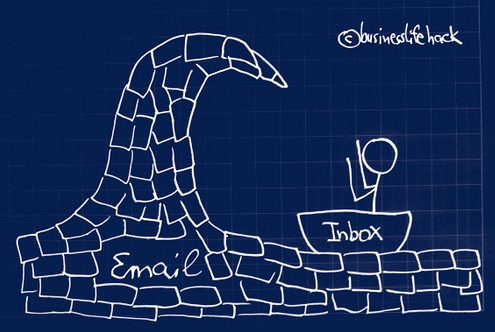Whether we’ll admit it or not, our inboxes can be addictive.
After all, checking email is as easy as tapping an app or refreshing a web browser. Is there a new and exciting business opportunity waiting for you? Will your web developer finally send an update on the shopping cart project? Is your realtor ever going to sell your house? Checking email gives us hope that our dreams will soon be realized.
Addictions aside, email inboxes actually make a terrible to-do list. Sadly, many businesses use email to structure their work days. Despite the prevalence of affordable project management apps, some people just can’t break free from the shackles of email.
In this post, we’ll discuss six reasons why you should stop using your inbox as a to-do list.
1. Your Inbox Doesn’t Care About Importance
There are only so many hours in a work day. As a business owner, you rarely run out of things to keep you busy. Pitching new clients, dealing with employee issues, and developing game-changing strategies are all in a typical day’s work. With so much on your plate, you can’t afford to waste time on non-value-added stuff. In fact, you take great pride in your ability to efficiently identify (and solve) most problems that pop up.
With that being said, why do you spend so much time jumping between emails? Granted, it’s impossible to know when an important email will pop up. Keeping close watch on your inbox makes sense from that standpoint. On the other hand, I would wager that 90%+ of the emails you receive are less than important. If your inbox is anything like mine, you probably get a ton of stuff like this:
- Industry newsletters
- Emails from sales reps, who are trying to sell you things
- Promotional emails from your vendors
- Alerts from social media
- Low-priority requests from colleagues or clients
Worst of all, your inbox doesn’t put the most important things at the top. As additional emails arrive, important requests sink further down into obscurity.
Sure, you can try to keep pace by deleting and archiving unimportant messages. However, is this the best use of your time? Probably not.
2. You Can’t Mark an Email as “Done”
Let’s assume that you’ve somehow devised a process by which only “important” messages make it to your inbox. To do this, you unsubscribed from all non-essential messages, set filters to auto-forward any administrative emails to your assistant, and convinced customers and team members to reach out sparingly (good luck with that!).
Now your inbox is the perfect to-do list, right? Not so much.
To illustrate my point, let’s say that you have the following emails awaiting your attention:
Subject: Select the Company Picnic Venue
Subject: Please Sign Up for an Insightly Trial
Subject: Finish Slide Deck for Next Week’s Proposal
Being the productive person that you are, you’re able to complete these tasks in less than an hour. Unfortunately, all three “tasks” are still sitting in your inbox. What should you do with them now? Delete? Move to a folder? Do you need to respond to each person, indicating that you’re done? If so, how much time will that take?
Wouldn’t it be nice to just mark your tasks as “done,” and then move on with your life? Sadly, email doesn’t work that way.
3. Delegation is Messy
To add another layer of complexity, not every task fits neatly into a single email exchange.
Take, for example, the selection of a venue for the company picnic. What seemed like a relatively straightforward decision has quickly evolved into dozens of separate email threads. Shortly after sending your confirmation email, you received several additional emails from staff at the venue. Their accounts receivable department needs you to make a 25% deposit by the close of business. You also received a 12-page PDF, containing all sorts of parking information, menu options, and other important details. And, to top things off, the venue’s Executive Director wants to connect for coffee later this week.
All of these things can (and should) be delegated to someone else on your team. Here’s the problem: delegating from your inbox is messy.
Forwarding messages to your accounting department and virtual assistant won’t take much of your time. Problem is, there’s no guarantee that they’ll remember to follow up. Their inboxes are overflowing with tasks, too.
Alas, you bite the bullet, stop what you were doing, and spend another hour on administrative work.
4. Your Inbox Doesn’t Tell the Whole Story
You finally get to a good stopping point on the picnic stuff, and you check your inbox for the next thing to tackle. Great news awaits, as you learn that another hot prospect wants a proposal. Even better, the slide deck that you just finished for a different client can be easily adapted for this new prospect. Both essentially want the same service, but you’ll need to make a few adjustments (such as updating the client’s name, logo, and key assumptions).
At this point you think to yourself, “Aha! Finally something that I can delegate to my administrative assistant!” So, you find the related email threads and forward them along. You even walk over to your admin’s desk to stress the importance of this project.
A few days pass, and your administrative assistant stops with a troubled look on his face. He’s clearly confused by the assignment, as evidenced by his questions:
“So, which deck is the one that still needs to be updated?”
“Are we keeping the color schemes the same? Or, should I update the background colors to match the prospective client’s logo?”
“Speaking of logos, where do I find a copy of their logo?”
“What is the due date for this task?”
“Did you want to proofread a digital copy of this before I print it out?”
“Where should I save the finished copy once it’s done?”
Once again, your delegation plan has been foiled. Your team is normally very competent, so why is this project creating so much confusion?
As effective as your staff may be, they’re not mind readers. They’re looking for you to provide the necessary information to do their jobs. Just forwarding a bunch of disjointed email conversations only tells part of the story.
5. There’s Software Designed Specifically for Organizing To-Dos
By now, I hope you’ll agree that your inbox is letting you down. If so, you might be asking yourself what (if anything) you can do about it.
There is good news – as I alluded to at the onset of this post, there are many online software tools that can structure your company’s work. Insightly, which is perhaps best known for its sales management features, also provides a suite of integrated productivity tools. Let’s look at how Insightly could solve many of the headaches we’ve discussed.
Sequencing Important Work: Unlike your inbox, Insightly brings clarity to your most important tasks. Assign due dates, priority, completion, and status with a few clicks.

As due dates and priority levels are defined, it becomes much easier to see the “big picture.”

Tracking Completed Tasks: A task tracking system, like Insightly, will also fulfill your desire to check things off your list. Marking a task “done” is as easy as clicking a button.

Want to see a historical archive of the great work you’ve done? Jump over to your “completed tasks” view for a detailed review.

Delegating to Others: Getting the rest of your team into Insightly can also be beneficial. Rather than delegating from your inbox, Insightly provides a more structured workflow. Create tasks to occur on a one-time or repeating basis, thereby making the very act of delegation natively more efficient. To assign work to others, just select the correct team member from an intuitive dropdown. Connect the task to additional contributors or larger projects.

You can even add detailed notes to ensure your team is always in the know. No more excuses!
Connecting Sales & To-Dos: For added context on sales-related tasks, you can easily link items to opportunities in your pipeline. Within a click or two, your team has access to information that would otherwise only reside in your brain.

6. The Rest of Your Team is Following Your Lead
Leadership comes from the top – even when it involves juggling mundane tasks.
By continuing to rely on your broken inbox-dependent process, you’re telling the rest of your team to do likewise. Is this the best use of their time and your resources? I think not.
Take the bold step toward a more streamlined approach to productivity. Your team will thank you – and so will your bottom line.

Matt Keener is a marketing consultant and President of Keener Marketing Solutions, LLC. Matt specializes in content marketing and strategic planning, having helped numerous Saas (software as a service) companies and other small businesses worldwide. Read more of Matt’s work, get his book, or connect on LinkedIn.





















